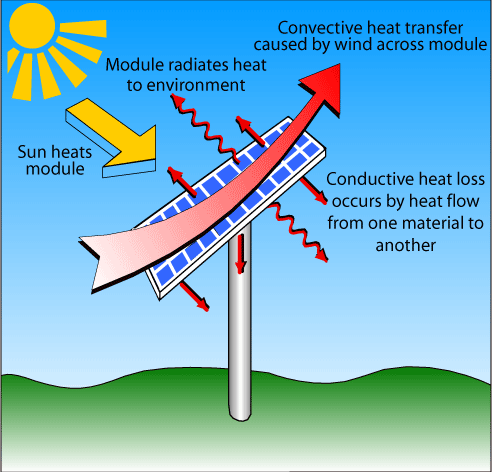The operating temperature of a PV module is an equilibrium between the heat generated by the PV module and the heat loss to the surrounding environment. There are three main mechanisms of heat loss: conduction, convection and radiation.

The module temperature is determined by the equilibrium between heat generated in the PV module by the sun and the conduction, convection and radiative heat loss from the module.
Heat Conduction
Conductive heat losses are due to thermal gradients between the PV module and other materials (including the surrounding air) with which the PV module is in contact. The ability of the PV module to transfer heat to its surroundings is characterized by the thermal resistance and configuration of the materials used to encapsulate the solar cells.
Conductive heat flow is analogous to conductive current flow in an electrical circuit. In conductive heat flow, the temperature differential is the driving force behind the conductive flow of heat in a material with a given thermal resistance, while in an electric circuit the voltage differential causes a current flow in a material with a particular electrical resistance. Therefore, the relationship between temperature and heat (i.e., power) is given by an equation similar to that relating voltage and current across a resistor. Assuming that a material is uniform and in a steady state, the equation between heat transfer and temperature is given by:
![]()
where:
Pheat is the heat (power) generated by the PV module discussed in Heat Generation in PV Modules;
Φ is the thermal resistance of the emitting surface in °C W-1; and
ΔT is the temperature difference between the two materials in °C.
The thermal resistance of the module depends on the thickness of the material and its thermal resistivity (or conductivity). Thermal resistance is similar to electrical resistance and the equation for thermal resistance is:

where:
A is the area of the surface conducting heat;
l is the length of the material through which heat must travel; and
k is the thermal conductivity in units of W m-1 °C-1.
To find the thermal resistance of a more complicated structure, the individual thermal resistances may be added in series or in parallel. For example, since both the front and the rear surface conduct heat from the module to the ambient, these two mechanisms operate in parallel with one another and the thermal resistance of the front and rear accumulate in parallel. Alternatively, in a module, the thermal resistance of the encapsulant and that of the front glass would add in series. A diagram of the thermal resistance of a simple PV module neglecting the conductance of the frames and edging is shown above.
Convection
Convective heat transfer arises from the transport of heat away from a surface as the result of one material moving across the surface of another. In PV modules, convective heat transfer is due to wind blowing across the surface of the module. The heat which is transferred by this process is given by the equation:
![]()
where:
A is the area of contact between the two materials;
h is the convection heat transfer co-efficient in units of W m-2 °C-1; and
ΔT is the temperature difference between the two materials in °C.
Unlike the thermal resistance, h is complicated to calculate directly and is often an experimentally determined parameter for a particular system and conditions.
Radiation
A final way in which the PV module may transfer heat to the surrounding environment is through radiation. As discussed in the Blackbody Radiation page, any object will emit radiation based on its temperature. The power density emitted by a blackbody is given by the equation:
![]()
where:
P is the power generated as heat by the PV module;
σ is the Stefan-Boltzmann constant as given in the Constants page; and
T is the temperature of the solar cell in K.
However, a PV module is not an ideal blackbody and to account for non-ideal blackbodies, the blackbody equation is modified by including a parameter called the emissivity, ε, of the material or object. A blackbody, which is perfect emitter (and absorber) of energy has an emissivity of 1. An emissivity of an object can often be gauged by its absorption properties, as the two will often be very similar. For example metals, which tend to have reduced absorption, also have a lower emissivity, usually in the range of 0.03. Including the emissivity in the equation for emitted power density from a surface gives:
![]()
where:
ε is the emissivity of the surface; and
the remainder of the parameters are as above.
The net heat or power lost from the module due to radiation is the difference between the heat emitted from the surroundings to the module and the heat emitted from the PV module to the surroundings, or in mathematical format:
![]()
where:
Tsc is the temperature of the solar cell;
Tamb is the temperature of the ambient surrounding the solar cell; and
the remainder of the parameters are as above.
